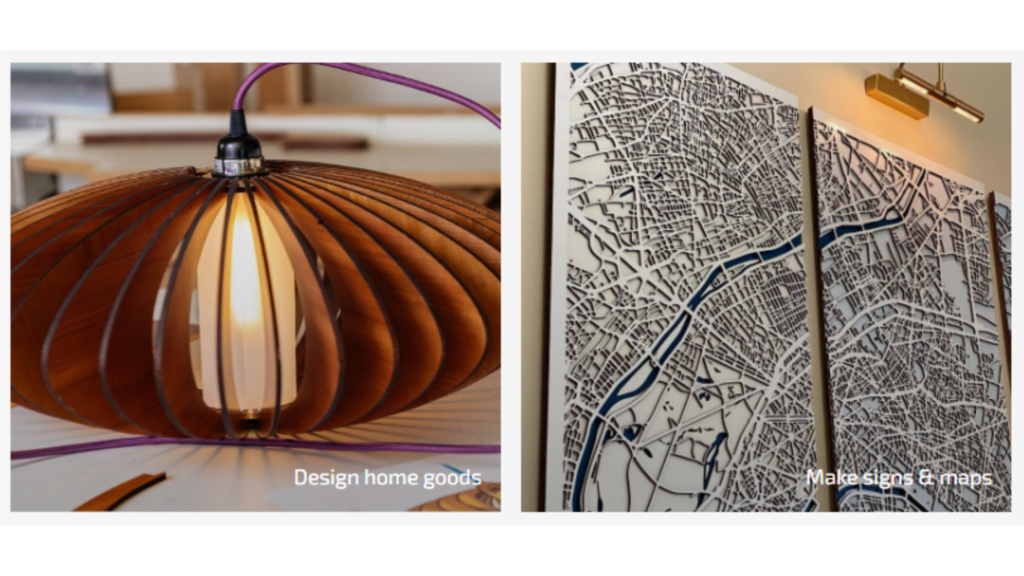Glowforge Review in 2025: Where It Shines and Where It Falls Short
Glowforge has made laser cutting and engraving more accessible to creators, educators, and small business owners. The standard model stands out for its compact design, intuitive interface, and ability to handle materials like wood, acrylic, and leather with ease.
By 2025, it remains a solid choice for crafting personalized items, prototypes, and classroom tools. Its strengths include clean design, browser-based software, and reliable performance for everyday creative needs. However, it does come with some limitations. An always-online requirement, no passthrough slot, and slower speeds compared to advanced models may restrict users looking for more flexibility or production power.
The base Glowforge is still a capable tool for hobbyists and light commercial use, offering quality and simplicity in one package. Understanding its advantages and drawbacks can help determine if it’s the right fit for your workflow.
Quick Verdict: Still a Solid Choice in 2025?
Glowforge remains a reliable choice for hobbyists, educators, and small businesses, offering easy setup, a user-friendly interface, and consistent results on common materials.
Where Glowforge Delivers
The standard model stands out for its simplicity and thoughtful design. Setup takes minutes, and the workflow is intuitive—even for beginners. Features like auto material recognition and camera-guided alignment reduce manual steps and make the process more creative than technical.
Its compact size fits well in home studios or classrooms, while the clean interface and browser-based software make it easy to go from design to finished piece with minimal friction.
Where It Stumbles
Glowforge’s reliance on cloud-based processing means it can’t operate without an internet connection, which may be limiting for users who prefer offline access or greater file control.
It also lacks expandability. Without a passthrough slot or rotary tool support, it’s restricted to standard-sized, flat materials. While performance is solid for everyday use, it runs slower than higher-end models, making it less ideal for heavy production.
Design, Build, and Setup Experience

Glowforge offers a balance of sleek design and everyday functionality, making it a practical choice for creators working in compact spaces. From hardware layout to software flow, every element is designed to simplify the creative process from the start.
Sleek Yet Functional Design
The standard model features a clean, minimalist look with a desktop-friendly footprint. Its form is lightweight but solid, built for stability during operation. Key design features include:
- See-through lid for monitoring progress in real time
- Onboard wide-angle camera for accurate material placement
- Front-loading tray for easy access to materials
These elements give users a clear view and greater control throughout the process.
Setup Process
Initial setup is quick and intuitive. After unboxing, users only need to plug the machine in, connect it to Wi-Fi, and log in through a web browser. The Glowforge app guides the alignment process, automatically recognizing materials and suggesting cut settings. Most users can go from setup to first project in under 30 minutes.
Still, before jumping into a purchase based on ease of setup, it helps to consider potential long-term missteps. This guide on avoiding common mistakes breaks down the most overlooked factors that first-time buyers should know.
Materials and Compatibility
Glowforge is designed to work with a wide range of flat materials, including wood, acrylic, leather, paper, fabric, and certain rubbers. While it can process third-party materials, it’s optimized for Proofgrade options, which come pre-finished and include QR codes for automatic setting adjustments. This ensures reliable results and simplifies material handling.
Glowforge works best with flat materials, especially Proofgrade options. If you need broader compatibility or want to explore alternatives, this 2025 buyer’s guide compares models based on material support and performance.
Ease of Use and Daily Workflow
Glowforge simplifies the creative process with an easy-to-use interface, accessible software, and minimal maintenance—suitable for users of any skill level.
Beginner-Friendly Interface
The Glowforge interface runs entirely in a web browser, requiring no downloads or installation. It works across most devices, including laptops, desktops, and tablets. Users can upload designs using simple drag-and-drop controls, then adjust placement directly on a real-time preview of the material bed. The visual layout minimizes guesswork and offers a smooth learning curve for new users.
Design Tools and Software
Glowforge’s built-in app includes basic design tools for simple shapes, text, and layout adjustments. For more complex projects, users can import designs from external software like Adobe Illustrator, Inkscape, or CorelDRAW. Supported file types include SVG, PDF, PNG, and JPG. Because everything operates through the cloud, users can access their projects from any connected device without installing dedicated software.
Daily Care and Maintenance
Ongoing maintenance is minimal and easy to manage. Routine tasks like cleaning the lens, checking mirrors, and removing debris from the crumb tray take just a few minutes. The app also provides helpful maintenance reminders based on usage, helping keep the machine in optimal condition with minimal downtime.
Engraving and Cutting Performance

The standard Glowforge performs consistently across a wide range of materials, making it a reliable tool for detailed engraving and light-duty cutting. While not the fastest option available, it delivers clean results that meet the expectations of most hobbyists and small-scale makers.
Engraving Precision
The laser head on the standard Glowforge is capable of producing detailed engravings with excellent control over depth and line quality. It performs especially well on flat surfaces that require fine detail and visual clarity.
- Crisp lines – Clean engraving on wood, leather, acrylic, and coated metals.
- Photo etching – Reproduces high-resolution images with smooth tonal transitions.
- Small text support – Maintains legibility even with intricate fonts or compact layouts.
These capabilities make it a strong fit for customized gifts, signage, branding, and decorative projects.
Cutting Power and Speed
Cutting is effective for a range of everyday materials, though performance tapers slightly with thicker or denser items. While it lacks the power of higher-tier models, the results are consistent and dependable for light production.
- Cuts up to 0.25 inches – Handles plywood, acrylic, leather, and fabric with ease.
- Moderate speed – Slower than the Glowforge Pro, especially with thicker materials.
- Ideal for low-volume work – Best suited for hobbyists, educators, and craft sellers.
For high-throughput production, users may find the pace limiting, but for typical daily use, it meets expectations.
Material Results
Best results are achieved when using Glowforge’s Proofgrade materials, which are calibrated for optimal performance. These materials come pre-finished, include scannable QR codes for automatic settings, and yield clean, consistent results. Third-party materials are supported as well, though they may require manual tuning and test passes to achieve the same level of quality. Users working with custom or untested materials should expect a learning curve to fine-tune performance.
Cloud-Only Operation: Convenience or Limitation?
Glowforge’s cloud-based system simplifies access and design processing, making it easy to use from any browser. However, it also limits offline functionality, file privacy, and local control.
Always-Connected Workflow
The machine requires an active internet connection to function. All design uploads, previews, and processing happen remotely on Glowforge’s servers. While this eliminates the need for software installation and enables updates without user input, it also means the device cannot operate offline. Interruptions in connectivity can delay or block access to projects entirely.
Privacy Considerations
All files used with Glowforge are stored within its cloud-based interface. This setup works well for personal or non-sensitive projects but may raise concerns for users handling proprietary designs. There is no option to store or process files locally, which limits control over file security and long-term storage preferences.
Premium vs. Free Plan
Glowforge offers two software tiers: Free and Premium. The Free plan includes all core functions, while Premium adds design tools, exclusive fonts, and faster processing—ideal for frequent users.
| Feature | Free Plan | Premium Plan |
|---|---|---|
| Design Upload & Print | ✔ Included | ✔ Included |
| Proofgrade Material Support | ✔ Included | ✔ Included |
| Drag-and-Drop Interface | ✔ Included | ✔ Included |
| Exclusive Fonts | ✘ Not Available | ✔ Available |
| Advanced Design Tools | ✘ Not Available | ✔ Available |
| Faster Rendering Speed | ✘ Standard Processing | ✔ Priority Processing |
| File Organization Tools | ✘ Basic Only | ✔ Enhanced Features |
For casual makers, the free plan is more than adequate. Power users managing frequent or high-volume work may find the Premium plan improves overall efficiency.
Cost and Value in 2025
Owning a Glowforge involves more than the initial purchase. While the cost may seem high, its ease of use and reliability make it a worthwhile investment for users seeking creative flexibility and consistent results.
Upfront Investment
The standard Glowforge is positioned at a price point that appeals to hobbyists, educators, and casual makers. It includes everything needed to get started, except for ventilation. For those who cannot vent through a window or wall, the optional Air Filter is a significant add-on, increasing the total cost. Still, for users seeking a plug-and-play setup with minimal technical hurdles, the price reflects the machine’s convenience and design.
Operating Costs Over Time
Running costs are relatively modest but should be factored into long-term planning. Consumables like lens wipes and replacement air filters are necessary for maintenance. To get a better sense of hidden costs and overlooked budget factors, this article on laser engraver mistakes is a practical resource.
Proofgrade materials, while convenient and high quality, tend to cost more than third-party alternatives. The optional Premium software subscription adds monthly value for those using the machine regularly, but it isn’t required for standard operation.
Who It’s Best Suited For
Glowforge is a strong fit for DIYers, educators, and home crafters who prioritize ease of use over customization. It delivers excellent results without requiring technical expertise. However, its limitations in speed, offline access, and scalability make it less suitable for production-heavy environments or businesses with large-volume demands.
This laser engraver comparison outlines top choices for different goals, from casual use to production-level work.
Conclusion: Still a Smart Buy, With Boundaries
The standard Glowforge remains a strong option for hobbyists, educators, and casual makers who want high-quality results with minimal setup or learning curve. Its browser-based interface, material auto-detection, and consistent performance make it easy to create polished projects using wood, acrylic, leather, and similar materials.
However, it has limitations. The always-online requirement, slower speed, and lack of passthrough or rotary support make it less suitable for professionals or high-volume workflows. For users focused on simplicity and everyday creative tasks, Glowforge still offers great value. For those needing more power or flexibility, higher-tier alternatives may be a better fit.

